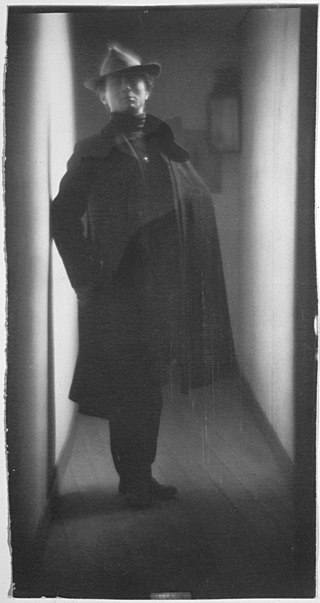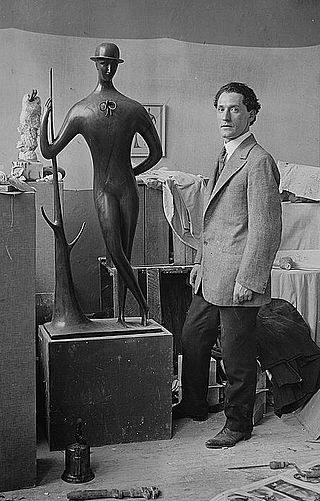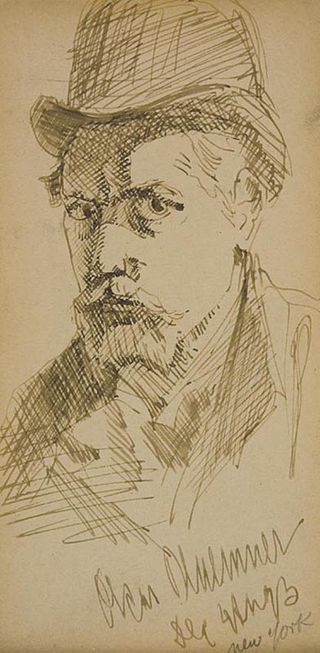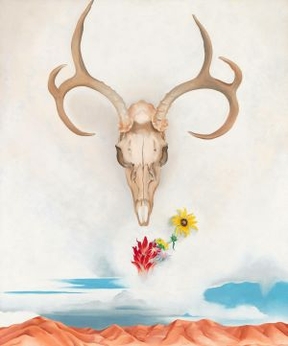Related Research Articles

Lyonel Charles Adrian Feininger was a German-American painter, and a leading exponent of Expressionism. He also worked as a caricaturist and comic strip artist. He was born and grew up in New York City. In 1887 he traveled to Europe and studied art in Hamburg, Berlin and Paris. He started his career as a cartoonist in 1894 and met with much success in this area. He also worked as a commercial caricaturist for 20 years. At the age of 36, he began to work as a fine artist. His work, characterized above all by prismatically broken, overlapping forms in translucent colors, with many references to architecture and the sea, made him one of the most important artists of classical modernism. Furthermore he produced a large body of photographic works and created several piano compositions and fugues for organ.

The Whitney Museum of American Art, known informally as "The Whitney", is a modern and contemporary American art museum located in the Meatpacking District and West Village neighborhoods of Manhattan in New York City. The institution was originally founded in 1930 by Gertrude Vanderbilt Whitney (1875–1942), a prominent American socialite, sculptor, and art patron after whom it is named.

Charles Henry Buckius Demuth was an American painter who specialized in watercolors and turned to oils late in his career, developing a style of painting known as Precisionism.

Alfred Stieglitz was an American photographer and modern art promoter who was instrumental over his 50-year career in making photography an accepted art form. In addition to his photography, Stieglitz was known for the New York art galleries that he ran in the early part of the 20th century, where he introduced many avant-garde European artists to the U.S. He was married to painter Georgia O'Keeffe.

Edward Jean Steichen was an American photographer, painter, and curator. He is considered among the most important figures in the history of photography.

Precisionism was a modernist art movement that emerged in the United States after World War I. Influenced by Cubism, Purism, and Futurism, Precisionist artists reduced subjects to their essential geometric shapes, eliminated detail, and often used planes of light to create a sense of crisp focus and suggest the sleekness and sheen of machine forms. At the height of its popularity during the 1920s and early 1930s, Precisionism celebrated the new American landscape of skyscrapers, bridges, and factories in a form that has also been called "Cubist-Realism." The term "Precisionism" was first coined in the mid-1920s, possibly by Museum of Modern Art director Alfred H. Barr although according to Amy Dempsey the term "Precisionism" was coined by Charles Sheeler. Painters working in this style were also known as the "Immaculates", which was the more commonly used term at the time. The stiffness of both art-historical labels suggests the difficulties contemporary critics had in attempting to characterize these artists.

Andreas Bernhard Lyonel Feininger was an American photographer and a writer on photographic technique. He was noted for his dynamic black-and-white scenes of Manhattan and for studies of the structures of natural objects.

Elie Nadelman was a Polish-American sculptor, draughtsman of the School of Paris and a collector of folk art.
American modernism, much like the modernism movement in general, is a trend of philosophical thought arising from the widespread changes in culture and society in the age of modernity. American modernism is an artistic and cultural movement in the United States beginning at the turn of the 20th century, with a core period between World War I and World War II. Like its European counterpart, American modernism stemmed from a rejection of Enlightenment thinking, seeking to better represent reality in a new, more industrialized world.

Oscar Bluemner, born Friedrich Julius Oskar Blümner and after 1933 known as Oscar Florianus Bluemner, was a Prussian-born American Modernist painter.
John Mason was an American artist who did experimental work with ceramics. Mason's work focused on exploring the physical properties of clay and its "extreme plasticity". One of a group of artists who had studied under the pioneering ceramicist Peter Voulkos, he created wall reliefs and expressionistic sculptures, often on a monumental scale.

Henry McBride was an American art critic known for his support of modern artists, both European and American, in the first half of the twentieth century. As a writer during the 1920s for the newspaper The New York Sun and the avant-garde magazine The Dial, McBride became one of the most influential supporters of modern art in his time. He also wrote for Creative Art (1928-1932) and Art News (1950-1959). Living to be ninety-five, McBride was born in the era of Winslow Homer and the Hudson River School and lived to see the rise of Jackson Pollock, Mark Rothko, and the New York School.

John Henry Bradley Storrs, also known as John Bradley Storrs and John H. Storrs, was an American modernist sculptor best remembered for his art deco sculptures that examined the relationship between architecture and sculpture.

Alma Marie Sullivan Reed (1889–1966) was an American journalist. While working in Mexico in the 1920s, she fell in love with the Governor of Yucatán, Felipe Carrillo Puerto; however, he was assassinated while she was home in San Francisco preparing for their wedding. Reed was a promoter of the career of Mexican muralist José Clemente Orozco and wrote the first monograph on the artist in 1932, as well as a biography about his life. She also wrote more generally on Mexican muralists.
Achim Moeller is a German-American art dealer, adviser, art historian, scholar and curator. He is the founder and head of Moeller Fine Art and the Achim Moeller Art Advisory.

Galka Scheyer was a German-American painter, art dealer, art collector, and teacher. She was the founder of the "Blue Four," an artists' group that consisted of Lyonel Feininger, Wassily Kandinsky, Paul Klee and Alexej von Jawlensky.
John G. Hanhardt is an American author, art historian, and curator of film and media arts. Hanhardt was the Consulting Senior Curator for Media Arts at the Smithsonian Museum of American Art, where he developed exhibitions, collections, and archives in film and the media arts. He is considered to be one of the leading scholars on video artist Nam June Paik.

Marion Hasbrouck Beckett was an American painter.
Grace M. Mayer was a curator of photography for the Museum of the City of New York and for the Museum of Modern Art.

Summer Days is a 1936 oil painting by the American 20th-century artist Georgia O'Keeffe. It depicts a buck deer skull with large antlers juxtaposed with a vibrant assortment of wildflowers hovering below. The skull and flowers are suspended over a mountainous desert landscape occupying the lower part of the composition. Summer Days is among several landscape paintings featuring animal skulls and inspired by New Mexico desert O'Keeffe completed between 1934 and 1936.
References
- ↑ "Haskell, Barbara". Dictionary of Art Historians. Retrieved 14 January 2015.
- ↑ "American Fellows". Whitney Museum of Art. Retrieved 14 January 2015.
- ↑ "24th Annual Frederic Church Awards".